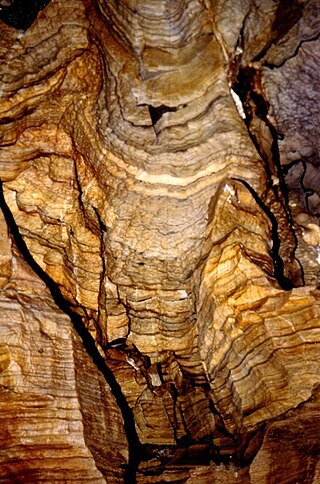Related Research Articles

Mammoth Cave National Park is a national park of the United States in south-central Kentucky. It encompasses portions of Mammoth Cave, the longest known cave system in the world. The park's 52,830 acres (21,380 ha) are located primarily in Edmonson County, with small areas extending eastward into Hart and Barren counties. The Green River runs through the park, with a tributary called the Nolin River feeding into the Green just inside the park.
Krubera Cave is the deepest known cave on Earth. It is located in the Arabika Massif of the Gagra Range of the Western Caucasus, in the Gagra District of Abkhazia, a disputed region of Georgia.

The Hawks' Club, founded in 1872, is a members-only social club for the leading sportsmen at the University of Cambridge. Membership is by election only, and the usual criterion is that the candidate should have his Blue. Many notable individuals have been, or are, members, including King George VI, King Charles III, Rob Andrew, Mike Atherton, Chris Brasher, Gavin Hastings and Hugh Laurie.

The Jeita Grotto is a system of two separate, but interconnected, karstic limestone caves spanning an overall length of nearly 9 kilometres (5.6 mi). The caves are situated in the Nahr al-Kalb river valley within the locality of Jeita, 18 kilometres (11 mi) north of the Lebanese capital Beirut. Though inhabited in prehistoric times, the lower cave was not rediscovered until 1836 by Reverend William Thomson; it can only be visited by boat since it channels an underground river that provides fresh drinking water to more than a million Lebanese.

The Marble Arch Caves are a series of natural limestone caves located near the village of Florencecourt in County Fermanagh, Northern Ireland. The caves are named after the nearby Marble Arch, a natural limestone arch at the upstream end of Cladagh Glen under which the Cladagh River flows. The caves are formed from three rivers draining off the northern slopes of Cuilcagh mountain, which combine underground to form the Cladagh. On the surface, the river emerges from the largest karst resurgence in Ireland, and one of the largest in the United Kingdom. At 11.5 kilometres (7.1 mi) the Marble Arch Caves form the longest known cave system in Northern Ireland, and the karst is considered to be among the finest in the British Isles.

Steinbrücken Cave was discovered by the Cambridge University Caving Club on the Loser Plateau in 1999. It is part of the large Schwarzmooskogel cave system, and is named after a nearby natural arch. The arch is in fact a former entrance to Traungold Cave (1623/231e) which has been developed into a convenient bivouac shelter for cave explorers. The SMK system is the 17th longest cave system in the world.

The Belum Caves, located in Nandyala district of Andhra Pradesh's Rayalaseema region, is the second largest cave system on the Indian subcontinent, known for its speleothems, such as stalactite and stalagmite formations. The Belum Caves have long passages, galleries, spacious caverns with fresh water and siphons. This cave system was formed over the course of tens of thousands of years by the constant flow of underground water from the now-disappeared river Chitravathi. The cave system reaches its deepest point at the point known as Pataalaganga. Belum Caves have a length of 3,229 m (10,593.8 ft), making them the second largest caves on the Indian Subcontinent after the Krem Liat Prah caves in Meghalaya. It is one of the centrally protected Monuments of National Importance.
There are a number of caving organizations throughout the world.
The Yorkshire Ramblers' Club (YRC) was founded in Leeds on 6 October 1892. It is the second-oldest mountaineering club in England, and the UK's oldest caving club, active in mountaineering and caving in the UK and internationally.

Cave del Valle, locally also known as La Viejarrona, is located near El Cerro Village in the municipality of Rasines in Cantabria, northern Spain. The cave is the source of the Silencio River, a tributary of the Rio Ruahermosa, which in turn is a tributary of the Asón River. Notable for its prehistoric, but particularly for its speleologic significance as it is recognized as one of the longest cavities in the world. The site is very popular among cavers, who have explored a total of over 60 km (37.28 mi) so far.

The Spannagel Cave is a show cave near Hintertux, in the Zillertal Alps in the Austrian state of Tyrol. Currently about 10 kilometres of the cave have been discovered; guided tours enable access to 500 metres of the cave. Its entrance lies below the Spannagelhaus, a mountain hut formerly run by the Austrian Tourist Club (ÖTK). The cave and the hut are named after Dr. Rudolf Spannagel, who was the president of the ÖTK from 1902 to 1904.
The Rising Star cave system is located in the Malmani dolomites, in Bloubank River valley, about 800 meters southwest of Swartkrans, part of the Cradle of Humankind World Heritage Site in South Africa. Recreational caving has occurred there since the 1960s. In 2015, fossils found there two years prior were determined to be a previously unknown extinct species of hominin named Homo naledi.

Charles William (Bill) Steele, Jr. is a cave explorer and speleologist who has led and participated in expeditions to many of the longest and deepest caves in the USA, Mexico, and China. He has explored hundreds of caves across North America and Asia and has written two books chronicling his expeditions: Yochib: The River Cave, and Huautla: Thirty Years in One of the World's Deepest Caves. TV shows such as National Geographic Explorer, NOVA and How’d They Do That? have aired programs on his expeditions.

The Caves of Meghalaya comprise a large number of caves in the Jaintia, Khasi Hills, and Garo Hills districts in the Indian state of Meghalaya, and are amongst the longest caves in the world. Of the ten longest and deepest caves in India, the first nine are in Meghalaya, while the tenth is in Mizoram. The longest is Krem Liat Prah in the Jaintia Hills, which is 30,957 m (101,600 ft) long. The word "Krem" means cave in the local Khasi language.

Sistema Huautla is a cave system in the Sierra Mazateca mountains of the southern Mexican state of Oaxaca. As of May 2024 it is the deepest cave system in the Western Hemisphere, 1,560 metres (5,120 ft) from the highest entrance to the lowest reached point in the cave system, with over 62 miles of mapped passageways. It is the ninth deepest cave in the world. It is also the 29th longest cave system with over 100 km length. Sistema Huautla has 30 entrances.

Boybuloq is a limestone cave in Uzbekistan, the deepest cave in Central Asia and all Asia except its western part. The cave is 1,517 metres (4,977 ft) deep and 18,400 metres (60,400 ft) long with the main entrance at an elevation of 2,647 metres (8,684 ft). It is situated at the edge of Baysun-Tau mountain ridge, the southern spur of the Gissar Range, in the southeast of the country. The nearest village is Dehibolo, to the northeast of Boysun.

Aleksandr Sergeyevich Vishnevsky was a Russian speleologist, most known for his cave exploration work in the Urals and in Uzbekistan. After 2000 the latter area of his work became one of the speleology hotspots as it includes the Boybuloq, the deepest cave in Central and East Asia, and one of the deepest caves in the world.

Pavel Yevgenyevich Demidov was a Russian speleologist, most known for his work in extreme cave exploration, especially as the leader of the Perovo-speleo team expeditions to Veryovkina Cave on Arabika massif in Abkhazia, from 2017 the deepest cave in the world.

Ekaterinburg Speleo Club (SGS) (from Sverdlovskaja Gorodskaja Speleosekcija; Свердловская Городская Спелеосекция – СГС), founded in 1961, is a Russian, non-profit speleological organization dedicated to the exploration, research, and conservation of caves. It is based in Ekaterinburg (named Sverdlovsk from 1924 to 1991), the fourth largest city of Russia, in the Middle Urals and on the western edge of Siberia. SGS is most known for the exploration of caves in the northern Sverdlovsk Oblast and high-mountain karst areas of Surxondaryo Region in Uzbekistan, including Boybuloq, the deepest cave in Central Asia and one of the deepest caves in the world.
References
- ↑ "Cambridge University Caving Club Publications" . Retrieved 22 January 2025.
- ↑ "Trips Abroad" . Retrieved 22 January 2025.
- ↑ "CUCC Austria Expeditions: Introduction" . Retrieved 23 May 2011.
- ↑ "CUCC's Austria expeditions: Primer" . Retrieved 21 January 2025.
- ↑ "EXCS: The Ex-Cambridge Speleologists" . Retrieved 21 January 2025.